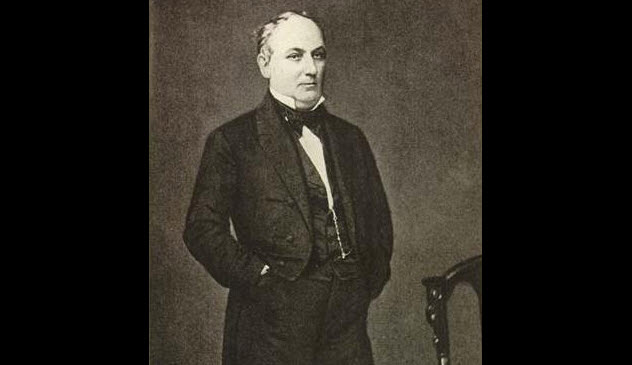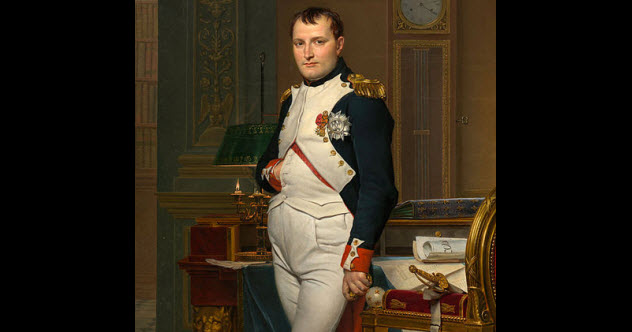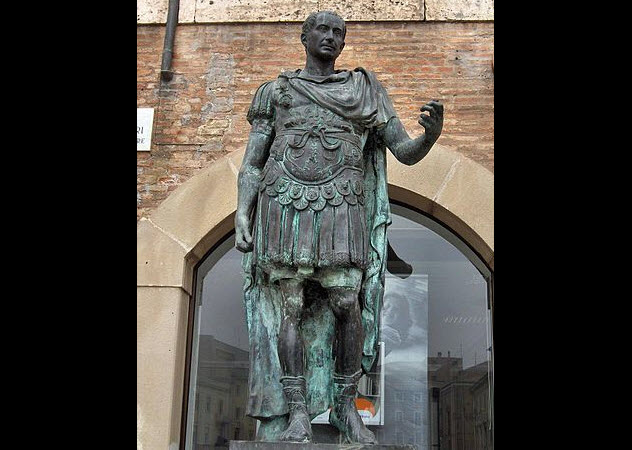 Mysteries
Mysteries  Mysteries
Mysteries  History
History 10 Surprising Stories About the Texas Rangers
 Humans
Humans 10 Philosophers Who Were Driven Mad by Their Own Theories
 Miscellaneous
Miscellaneous 10 Video-Game-Worthy Weapons and Armors from History
 Weird Stuff
Weird Stuff 10 Psychics Who Accurately Predicted Wartime Events
 The Arts
The Arts 10 Pieces of Art Inspired by a Broken Heart
 Health
Health 10 Science Fiction-Sounding New Medical Treatments
 History
History 10 Surprising Facts About the Father of Submarine Warfare
 Space
Space Ten Astonishing New Insights into Alien Worlds
 Weird Stuff
Weird Stuff 10 Bizarre Summer Solstice Rituals Still Practiced Today
 Mysteries
Mysteries Top 10 Haunting Facts About the Ghost Ship MV Alta
 History
History 10 Surprising Stories About the Texas Rangers
 Humans
Humans 10 Philosophers Who Were Driven Mad by Their Own Theories
Who's Behind Listverse?

Jamie Frater
Head Editor
Jamie founded Listverse due to an insatiable desire to share fascinating, obscure, and bizarre facts. He has been a guest speaker on numerous national radio and television stations and is a five time published author.
More About Us Miscellaneous
Miscellaneous 10 Video-Game-Worthy Weapons and Armors from History
 Weird Stuff
Weird Stuff 10 Psychics Who Accurately Predicted Wartime Events
 The Arts
The Arts 10 Pieces of Art Inspired by a Broken Heart
 Health
Health 10 Science Fiction-Sounding New Medical Treatments
 History
History 10 Surprising Facts About the Father of Submarine Warfare
 Space
Space Ten Astonishing New Insights into Alien Worlds
 Weird Stuff
Weird Stuff 10 Bizarre Summer Solstice Rituals Still Practiced Today
10 Naughty Sex Stories From History
It might not be part of the school curriculum, but sex is an integral part of history. Some might even say it’s one of the most interesting parts of history. After all, how many times can you learn about what king took the throne in what year and what empires fought in the battle of whatever before it gets boring? This time, we explore the salacious side of history with a few naughty but memorable stories.
SEE ALSO: 10 Strange Non-Sexual Ways People Have Orgasms
10 General Hooker’s Hookers

Even though Joseph Hooker was a competent general in the Union Army, he is now remembered for two things—his defeat at the Battle of Chancellorsville and his name becoming synonymous with prostitution. Hooker had a reputation as a drunk and a womanizer. His soldiers were undisciplined and followed his lead. Consequently, his Union camps were so often stocked with prostitutes that they became known as “Hooker’s Brigade,” later simply referred to as “hookers.”
Although it sounds like a convincing story, the word “hooker” referred to a prostitute before the Civil War. The earliest known instance was in a police report from 1835. The woman was called a hooker because she “hanged around the hook,” referring to Corlear’s Hook, an area of New York rife with prostitution.
Whether or not the general had anything to do with the origins of the term, he certainly popularized it. Hooker’s men frequented one area in the slums of Murder Bay, a neighborhood in Washington, DC, that became known as “Hooker’s Division” because it mostly housed prostitutes.
9 Mozart’s Scatological Fetish
There is no way to sugarcoat this—Wolfgang Amadeus Mozart was really into poop. If you thought that poop jokes were a product of the 20th century, just read some of the correspondence between Mozart and his cousin. He talks of his ass burning like fire because “muck” wanted to come out and presents his cousin/love interest with the following nursery rhyme: “I now wish you a good night, sh–t in your bed with all your might, sleep with peace on your mind, and try to kiss your own behind.”
Based on the letters exchanged between them, Mozart’s scatological fetish was likely encouraged by his parents. His mother used the same nursery rhyme as Mozart in correspondence with her husband, Leopold.
In general, Mozart’s scatological humor was accepted in his family and in German culture, although some people felt this side of the composer needed to be censored. For most of their existence, Mozart’s scatological letters weren’t published in their entirety. Modern psychiatrists offered medical explanations for his behavior, opining that Mozart may have had a form of Tourette’s syndrome.
Mozart also expressed his scatological interest in song form. He wrote several canons with vulgar lyrics that were merely party pieces for his friends during his lifetime. The most famous was “Lech mich im Arsch” (“Lick me in the ass”). After Mozart’s death, his widow sent the manuscript for publication, but the song was rewritten as “Let us be glad.” Today, however, you can listen to it just as the great composer intended (in the video above).
8 Hammond-Hampton Scandal

There was a time when James Henry Hammond was one of the most influential people in the US. From meager beginnings, Hammond married into the incredibly powerful and wealthy Hampton family in South Carolina. Eventually, Hammond owned numerous plantations and hundreds of slaves. He also served as a US senator, governor, and member of the House of Representatives.
Hammond’s political platform was always focused on slavery. He was one of slavery’s greatest supporters (mainly because it made him rich) and considered it a cornerstone of American society that was commanded by God.
Hammond’s secret diary revealed that he had a depraved sex life. He engaged in sexual relations, described as “familiarities and dalliances,” with four of his nieces, daughters of Wade Hampton II. He blamed them for seducing him, describing them as “extremely affectionate.”
When word of this got out, Hampton sought to destroy his brother-in-law both politically and socially. Hammond became ostracized by high society for almost a decade until he somehow got elected as a US senator from South Carolina.
Hammond also had a sexual relationship with two slaves. When one of the slaves’ daughters turned 12, he started an affair with her, too. In recent years, we’ve learned that Hammond maintained a homosexual relationship in college with a friend named Thomas Jefferson Withers.
7 Napoleon’s Little General

Body parts of the departed rich and famous have a way of mysteriously disappearing and ending up in museums or private collections. Out of all these appendages, none has had a stranger journey than Napoleon Bonaparte’s penis. In 1821, the member was removed from the French emperor when his doctor cut it off during Napoleon’s autopsy. From there, the penis made its way into the hands of the priest who performed Napoleon’s last rites.
The journey gets a bit murky in the middle, but it seems that the priest kept Napoleon’s penis in the family for about 100 years. Then it was given to a London bookseller who sold it to an American bookseller named A.S.W. Rosenbach in 1924. The public got its first glimpse of the historical “artifact” in 1927 when it went on display at the Museum of French Art in New York.
After a few unsuccessful attempts to sell the appendage, Napoleon’s penis was finally bought at auction in 1977 by American urologist John Lattimer. Since then, the penis has been with the Lattimers in New Jersey, occasionally coming out for documentaries that cruelly confirm what most of us already expected—that Napoleon had a tiny penis.
6 Jean-Jacques Rousseau’s Spanked Bottom

In the 18th century, philosopher Jean-Jacques Rousseau was highly influential in spreading the Enlightenment movement throughout Europe. His autobiographical work, Confessions, was particularly noteworthy as it popularized the concept of the modern autobiography. It also revealed to the world that Rousseau was really into spanking.
He talked at length about his need to be spanked to become aroused and even traced its origins to when he was eight years old. He was sent off to school and boarded with a minister and his sister, Miss Lambercier, whom Rousseau found quite attractive. She would spank the young Rousseau when he misbehaved. He found this quite desirable and would often commit new offenses just to get punished again.
The practice stopped when Rousseau got older, but this did nothing to deter his desires. As a teenager, Rousseau had to find other ways to get his fix. He would walk up to groups of women and expose his bottom in the hopes that one of them would slap it out of indignation. When he became an adult, Rousseau was finally able to obtain his sexual gratification at the hands of an eager and open-minded mistress.
5 Droit du Seigneur

This practice went by many names: droit du seigneur, jus primae noctis, the lord’s right. They all refer to a medieval practice that allowed the lord of the manor to have sex with peasant brides under his vassalage on their wedding night.
It’s hard to establish the validity of such a custom. The first mention of it comes from the 4,000-year-old Epic of Gilgamesh where the king couples with the bride-to-be in front of the bridegroom. There were also non-European tribes where chieftains would deflower the women when they came of age or got married. However, as far as medieval Europe is concerned, the lord’s right seems to be a myth. There is no concrete historical evidence to suggest that this practice regularly took place anywhere in Europe during the Middle Ages.
It is possible that the lords practiced certain humiliating exercises that were symbolic of the droit du seigneur but not actual intercourse. Often, the vassals were expected to pay a sum of money so that the lord would not exercise his right. In reality, the practice was more about the lords showing their dominance and extorting money rather than upholding some kind of ancient custom.
4 World’s First Celeb

The name Kitty Fisher might be familiar to some from the old nursery rhyme: “Lucy Locket lost her pocket, and Kitty Fisher found it.” Both of them were real people—18th-century prostitutes, to be exact. However, Ms. Fisher climbed the social ladder and came to be regarded as the world’s first celebrity.
She was a celebrity in the sense that the public was obsessed with her, even though she wasn’t royalty or an artist or anyone with any kind of distinguishable talent. She was the first to be “famous for being famous,” a quality which is quite common among the “celebutantes” of today. In 1759, one notable incident occurred when Ms. Fisher fell off a horse and revealed that she wasn’t wearing underwear.
This wardrobe malfunction brought her instant notoriety, and Kitty capitalized on it by commissioning a portrait by celebrated artist Joshua Reynolds. She then printed thousands of small copies of the image so that her male admirers could carry her around in their snuffboxes or watchcases.
Some memorable tidbits regarding Kitty Fisher were provided by infamous Italian lover Casanova that showed how hugely successful she was. He said that Ms. Fisher once ate a 1,000-guinea note on bread and butter and that when he first met her, Kitty was wearing 500,000 francs worth of diamonds. At the same time, Casanova was told that he could sleep with her for 10 guineas, but he refused because she didn’t speak Italian.
3 The Bona Dea Affair

Ancient Rome was full of sex and scandal. Case in point: the Bona Dea festival which was only open to women. In 62 BC, it became a hotbed of controversy when tribune Publius Clodius Pulcher (commonly referred to simply as “Clodius”) dressed as a woman to infiltrate the festival. It was rumored that he went there to seduce Julius Caesar’s wife Pompeia, although no one seemed to know why.
Clodius wronged Caesar on two accounts: by disturbing the sacred ceremony that was held at Caesar’s house and by raising the suspicion that Clodius had an affair with Caesar’s wife. How much of this actually happened, though, remains a bone of contention. According to Plutarch, Clodius was acquitted of all charges. However, this didn’t stop Caesar from divorcing Pompeia because, as the proverb says, “Caesar’s wife must be above suspicion.”
The main reason we can’t be sure what really happened is Cicero. He provided testimony against Clodius, but they were mortal enemies. Even after Clodius’s acquittal, the scandal had a huge negative impact on his political career.
Interestingly enough, some modern historians believe that Cicero’s motivation might have been personal, not political. His wife, Terentia, also had cause to dislike Clodius—either because she was jealous of his sister Clodia or because Clodius prosecuted Terentia’s half-sister, Fabia, on charges of incest. It’s possible that Terentia might have been pulling the strings behind this sex scandal all along.
2 The Cleveland Street Scandal

Prince Albert Victor, grandson of Queen Victoria, is from a largely forgotten branch of the royal family. Haunted all his life by rumors regarding his mental health, he died at age 28 during a flu pandemic. The prince is best remembered today as one of the most intriguing (although highly unlikely) suspects in the Jack the Ripper case. He might also have been involved in one of the biggest sex scandals of Victorian England.
In summer 1889, a male brothel on Cleveland Street in London was raided by police after they found out that young messenger boys were prostituting themselves to high-class clientele. Back then, homosexuality was still illegal, but that’s not what caused the scandal. The uproar was caused by all the high-ranking officials and lords rumored to have been caught in the raid, including Prince Albert Victor.
It was never proven that the prince was there, although some point to a royal cover-up as the reason. The British media refrained from openly talking about the subject, but across the waters, French and American newspapers had no such qualms. Prince Albert Victor was quickly sent away on a tour of India in the hopes that the scandal would blow over. But he became inexorably linked with the “den of infamy” that was Number 19 Cleveland Street.
1 The Grafenberg Spot

Back in the 1950s, German gynecologist Ernst Grafenberg described an area of the female anatomy that still causes controversy after over 60 years of intense study: the G-spot. At that time, Grafenberg was studying the urethra and its role in female orgasms. His work led him to the “Grafenberg ring,” the first intrauterine device (IUD). However, during his research, the gynecologist also described “an erotic zone that always could be demonstrated on the anterior wall of the vagina along the course of the urethra.” Later, other scientists named this mystery zone the “Grafenberg spot” in his honor, later shortened to “G-spot.”
The reason the G-spot has been so controversial is that scientists are still arguing over its existence. There are plenty of women who claim to have it, and certain doctors describe it as a zone which is more sensitive to stimulation on the anterior wall of the vagina.
Other researchers deny the existence of the G-spot in anyone. Recently, a review looked at 96 different studies of the G-spot in the 60 years after Grafenberg described it and concluded “without a doubt” that the G-spot does not exist.
Radu is a history/science buff with an interest in all things bizarre and obscure. Share the knowledge on Twitter or check out his website.








